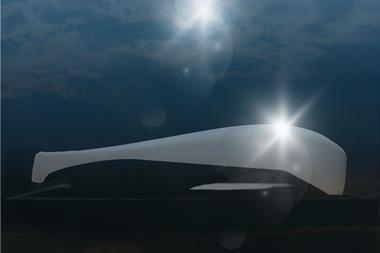Though tooling costs and shorter production runs bring advantages, reduced mass is pushing development
Compared to steel or aluminium body structures the number one advantage of composites is mass reduction. “That is really the single most important driving factor that is leading to the drive to include more composites,” says Will Harney, executive director research and development at Magna Exteriors and Interiors.
“This mass reduction can improve the vehicle’s fuel economy, ride handling and performance as well as occasionally improving the overall vehicle design,” he says. “It is not as restrictive as steel or metal pressings when it comes to geometries, so it provides some additional benefits when it comes to geometric freedom and part configurations.”
Mass reduction and fuel consumption
 With fuel economy driven by increasingly tighter regulation, consumers are increasingly looking for vehicles that meet the latest regulations and that shield them from escalating fuel prices.
With fuel economy driven by increasingly tighter regulation, consumers are increasingly looking for vehicles that meet the latest regulations and that shield them from escalating fuel prices.
“Weight reduction is a huge benefit, as is the fact that the composite parts don’t require any corrosion protection in terms of coatings; they are inherently free from corrosion issues,” Harney adds. “Almost every metal part in a vehicle requires coating, often in mass.
“By using carbon fibre composites it is possible to have 55% or 60% mass reduction on a composite part compared to its metal equivalent. “The other big difference is that the tools used to produce composites are, in the main fairly simple, so from a cost perspective they are lower than a similar metal-pressing tool.”
A second dimension in the costing scenario is that to form complex shapes with metals – primarily steel or aluminium – the metal must be taken through a series of progressional steps. So, for example, a body outer panel typically requires four and often up to six tools to progress the part from a flat, two-dimensional sheet to the final item. After that there is a tool required to trim the final part as well as an assembly tool.
 “If you look at the actual investment in tooling that auto manufacturers have to absorb in any new programme, the amount for composites is far lower than it is for pressed metal components,” Harney says.
“If you look at the actual investment in tooling that auto manufacturers have to absorb in any new programme, the amount for composites is far lower than it is for pressed metal components,” Harney says.
“That is one aspect of the cost, but you need to consider the composite cycles – the time it takes to make each part,” he adds. “For composites that has traditionally been quite long – minutes as opposed to seconds for metal-pressed part. So the volume of metal-pressed parts that can be formed from a tool on an annual basis is higher than can be produced by a composite tool, even with the reduced composite cycle times.”
Overall, there has been a general downwards trend in the number of units per vehicle model produced annually over the past ten years due to hyper competition and very tight segmentation. This is driving consolidation in the business but there are definitely more models competing for the same market share in tighter segments, which is resulting in lower vehicle volumes being produced for each model each year in each region. As the average volume for each model drops, it brings it into the economic range where composite tooling could support the annual requirements.
“Traditionally, with a composite like a sheet moulding compound SMC composite component for semi-structural applications you could usually produce 100-120,000 components a year from a single tool set,” Harney says. “If you look at models that are produced at volumes of less than 120,000 a year that puts it into a zone where composite tooling can have a significant advantage over pressed metal components.”
Lightweight construction technologies are steadily gaining ground in the automotive industry as the weight savings they achieve in modern cars help to significantly reduce fuel consumption and carbon emissions. Working with Benteler, Henkel has developed a process for the resin transfer moulding (RTM) of glass-fibre-reinforced leaf springs that uses a polyurethane matrix resin. Compared to conventional leaf springs made of steel, these composite leaf springs are up to 65% lighter.
Curing time is one challenge with the use of composites. With Loctite Max 2, Henkel has developed a polyurethanebased composite matrix resin that cures significantly faster than the epoxy products usually employed for the RTM process. Due to its low viscosity, the polyurethane resin penetrates and impregnates the fibre material more easily and less harshly, thus enabling very short injection times to be applied.
One special feature is its exceptionally high stress intensity factor, which is a measure of toughness. This toughness also has a positive effect on the fatigue behaviour under load. Since leaf springs are constantly subjected to dynamic loading under driving conditions, so the use of flexible materials with a high fatigue tolerance considerably prolongs the life of such components.
Resin injection processes such as RTM predominate in the manufacture of automotive composites for mass-produced cars because they make it possible to control the curing reaction more reliably, either by adjusting the temperature or adding an accelerator. Furthermore, the risk of local overheating and resulting shrinkage is reduced as the polyurethane resin generates less heat overall during curing than epoxy resins do. As a result, even thick components with many fibre layers cure fast. The RTM process is especially attractive as fast curing of the matrix resin permits short cycle times to be achieved.
The composite components, which are designed specifically for mass production, consist mainly of carbon and glass fibres in various textile forms such as stitched or woven fabrics.
“We have succeeded in producing a resin transfer moulded, glass-fibre reinforced leaf spring for the automotive industry that not only combines low weight with high strength but is also mass production capable. Thus, it also satisfies the highest expectations in terms of costefficiency and process reliability,” says Frank Fetscher, head of sales and marketing at Benteler Automotive Composites.
As with all facets of the automotive industry, environmental concerns play an important factor in a technology’s development, and the same is true with composites. The primary benefits of composites occur during their use phase. Both their production and end-of-life disposal carry serious environmental concerns.
In an attempt to alleviate some of these concerns the industry has been looking closely at environmentally friendly alternatives. One such approach is to integrate wood fibre in auto parts.
The Centre for Research and Innovation in the Bio- Economy (CRIBE), in Canada, is partnering with Magna Exteriors and Interiors on a project to integrate wood fibre in auto parts. Magna plans to develop high volume process and product technology that integrates wood fibres from Northern Ontario and Canadian-sourced pulp into its automotive parts. Currently, Magna moulds a number of components and sub-systems using long glass-filled polypropylene (LGFPP) for global automotive manufacturers.
In certain applications glass fibre can be substituted with wood fibre while providing the required mechanical and physical properties and offering a lower cost and lighter weight option. Once initial testing is complete, the goal will be to increase percentages of wood fibre for further optimised performance.





































